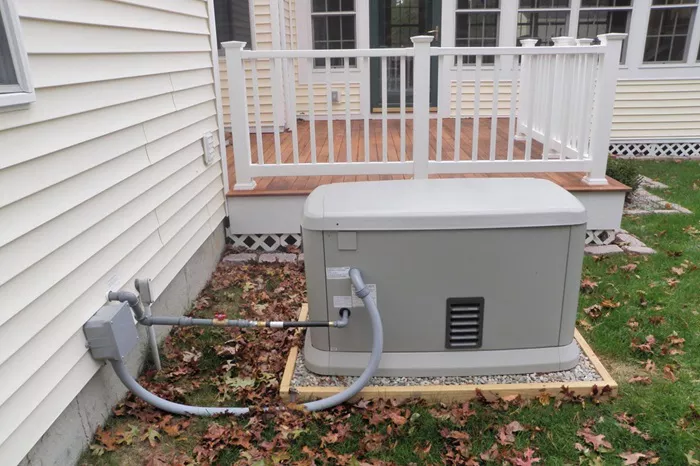Home generators provide backup power during outages, ensuring essential appliances and systems stay running. They automatically or manually supply electricity when the main grid fails, making them invaluable in emergencies. Understanding how they work helps homeowners choose the right model and maintain it properly.
This guide explains the types of home generators, their components, and their operation in simple terms while incorporating professional electrical knowledge.
Types of Home Generators
Portable Generators
Portable generators are smaller, movable units that run on gasoline, propane, or diesel. They power select appliances via extension cords or a transfer switch.
Pros:
- Affordable
- Easy to transport
- Good for short-term use
Cons:
- Manual operation required
- Limited power output
- Must be used outdoors to prevent carbon monoxide poisoning
Standby Generators
Standby generators are permanently installed outside homes and automatically turn on during outages. They connect directly to the home’s electrical system via a transfer switch.
Pros:
- Automatic operation
- Higher power capacity
- Runs on natural gas or propane
Cons:
- Expensive installation
- Requires professional maintenance
Inverter Generators
Inverter generators produce clean, stable power suitable for sensitive electronics. They adjust engine speed based on load, improving fuel efficiency.
Pros:
- Quiet operation
- Energy-efficient
- Safe for laptops and phones
Cons:
- Higher cost
- Lower power output than standby models
Key Components of a Home Generator
Engine
The engine drives the generator, converting fuel (gasoline, diesel, propane, or natural gas) into mechanical energy. Larger engines produce more electricity.
Alternator
The alternator converts mechanical energy into electrical energy through electromagnetic induction. It consists of a rotor (moving part) and a stator (stationary part).
Fuel System
The fuel system stores and delivers fuel to the engine. It includes:
- Fuel tank
- Pump (for standby generators)
- Carburetor or fuel injectors
Voltage Regulator
This ensures stable voltage output by adjusting the current supplied to the rotor. Without it, voltage fluctuations could damage appliances.
Cooling & Exhaust Systems
Cooling System: Prevents overheating (air or liquid-cooled).
Exhaust System: Vents harmful gases like carbon monoxide away from living spaces.
Control Panel
The control panel includes:
- Start/stop controls
- Voltage and frequency meters
- Circuit breakers for overload protection
Transfer Switch (For Standby Generators)
A transfer switch disconnects the home from the grid and connects it to the generator automatically when power fails.
How a Home Generator Works Step-by-Step
Power Failure Detection
Standby generators use a sensor to detect grid power loss. Portable generators require manual startup.
Engine Startup
- The engine starts using a battery (standby) or pull cord (portable).
- Fuel mixes with air in the combustion chamber, creating energy.
Electricity Generation
- The engine spins the alternator’s rotor inside the stator, producing an electromagnetic field.
- This induces an alternating current (AC) in the stator windings.
Voltage Regulation
The voltage regulator adjusts the current to maintain a steady 120V or 240V output.
Power Distribution
Standby Generators: The transfer switch routes power to the home’s electrical panel.
Portable Generators: Appliances are plugged directly into outlets or via extension cords.
Shutdown When Grid Power Returns
Standby generators shut off automatically, while portable units must be turned off manually.
Safety Considerations
Proper Ventilation
Generators emit carbon monoxide (CO)—always operate them outdoors.
Correct Wiring
Using a transfer switch prevents backfeeding, which can electrocute utility workers.
Regular Maintenance
- Change oil and filters periodically.
- Test the generator monthly.
- Keep fuel fresh (use stabilizers for long-term storage).
Load Management
Avoid overloading the generator—calculate wattage needs before use.
Choosing the Right Generator
Determine Power Requirements
Add up the wattage of essential appliances (e.g., fridge + lights + sump pump).
Fuel Type Considerations
Gasoline: Easily available but flammable.
Propane/Natural Gas: Cleaner but requires a fixed line.
Diesel: Efficient but noisy.
Runtime Needs
Standby generators can run for days, while portable models last 6–18 hours per tank.
Noise Levels
Inverter generators are quieter (50–60 dB) compared to conventional models (70+ dB).
Conclusion
Home generators are essential for uninterrupted power during outages. Whether you choose a portable, standby, or inverter model, understanding their components and operation ensures safe and efficient use. Regular maintenance and proper installation extend their lifespan while keeping your household safe. By selecting the right generator based on power needs, fuel type, and safety features, homeowners can stay prepared for any emergency.
This guide simplifies complex electrical concepts while providing actionable insights for generator selection and maintenance. Would you like additional details on any section?

